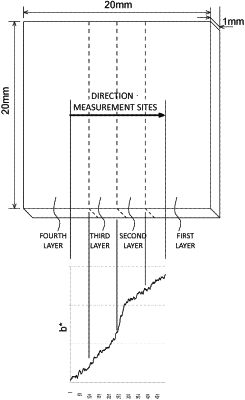| CPC A61C 13/0022 (2013.01) [A61C 13/082 (2013.01); A61C 13/083 (2013.01); A61C 13/09 (2013.01); B32B 18/00 (2013.01); C04B 35/48 (2013.01); C04B 35/486 (2013.01); C04B 35/488 (2013.01); C04B 35/4885 (2013.01); C04B 35/64 (2013.01); C04B 2235/3206 (2013.01); C04B 2235/3208 (2013.01); C04B 2235/3217 (2013.01); C04B 2235/3224 (2013.01); C04B 2235/3225 (2013.01); C04B 2235/3229 (2013.01); C04B 2235/3241 (2013.01); C04B 2235/3272 (2013.01); C04B 2235/3418 (2013.01); C04B 2235/5445 (2013.01); C04B 2235/604 (2013.01); C04B 2235/765 (2013.01); C04B 2235/81 (2013.01); C04B 2235/96 (2013.01); C04B 2235/9653 (2013.01); C04B 2235/9661 (2013.01); C04B 2237/348 (2013.01); C04B 2237/66 (2013.01); C04B 2237/704 (2013.01)] | 5 Claims |

|
1. A zirconia pre-sintered body configured for dental milling, grinding, and/or cutting, the body comprising a plurality of pre-sintered layers,
wherein the zirconia pre-sintered body has a flexural strength of a test sample of the zirconia pre-sintered body, measured pursuant to JISR1601, is not less than 90% of the flexural strength of a comparative zirconia pre-sintered body,
wherein the test sample being formed by:
preparing a plurality of zirconia powders, each comprising zirconia and yttria as a stabilizer that suppresses phase transition of zirconia, the plurality of zirconia powders differing in composition,
laminating the plurality of zirconia powders to form a plurality of zirconia powder layers;
vibrating the zirconia powder layers to produce interlayer boundary portions having compositional mixtures of respective zirconia powders of respective adjacent pairs of the plurality of zirconia powder layers; and
pre-sintering the plurality of zirconia powder layers to form the zirconia pre-sintered body;
wherein as a result of sintering, each of the plurality of zirconia powders becomes a respective one of the layers of the plurality of pre-sintered layers, the interlayer boundary portions of the plurality of sintered layers having a gradient of the compositional mixture of each of the respective adjacent pairs of the plurality of sintered layers,
wherein the comparative zirconia pre-sintered body is formed by pre-sintering one composition of the plurality of zirconia powders alone at the same temperature as a pre-sintering temperature of the test sample, and
wherein the flexural strength of the test sample is measured under a condition that a load point of a three-point bending test is positioned at a position of an interlayer boundary of the pre-sintered layers, the interlayer boundary traversing the test sample of the pre-sintered body along a direction of load application.
|
|
4. A zirconia pre-sintered body configured for dental milling, grinding, and/or cutting, the body comprising a plurality of pre-sintered layers,
wherein the zirconia pre-sintered body has a flexural strength of a test sample of the zirconia pre-sintered body, measured pursuant to JISR1601, is not less than 90% of the flexural strength of a comparative zirconia pre-sintered body,
wherein the test sample being formed by:
preparing a plurality of zirconia powders, each comprising zirconia and yttria as a stabilizer that suppresses phase transition of zirconia, the plurality of zirconia powders differing in composition,
laminating the plurality of zirconia powders to form a plurality of zirconia powder layers; and
pre-sintering the plurality of zirconia powder layers to form the zirconia pre-sintered body;
wherein as a result of sintering, each of the plurality of zirconia powders becomes a respective one of the layers of the plurality of pre-sintered layers, interlayer boundary portions of the plurality of sintered layers having a gradient of the compositional mixture of each of the respective adjacent pairs of the plurality of sintered layers,
wherein, in direction traversing the plurality of sintered layers, a b* color chromaticity value is non-constant and increases constantly in a direction traversing the plurality of sintered layers, including the interlayer boundary portions,
wherein the comparative zirconia pre-sintered body is formed by pre-sintering one composition of the plurality of zirconia powders alone at the same temperature as a pre-sintering temperature of the test sample,
wherein the flexural strength of the test sample is measured under a condition that a load point of a three-point bending test is positioned at a position of an interlayer boundary of the pre-sintered layers, the interlayer boundary traversing the test sample of the pre-sintered body along a direction of load application, and
wherein the plurality of zirconia powders comprise at least one pigment in different ratios, respectively.
|